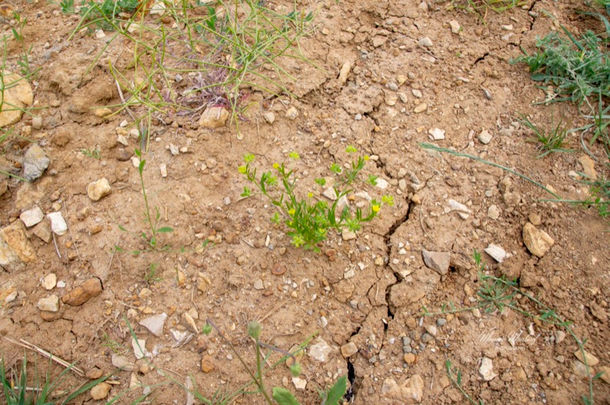Family |
Ranunculaceae
Ranunculus arvensis
L.
Ranunculus arvensis L.
(Sp. Pl.: 555; 1753 – Nouvelle Flore du Liban et de la Syrie, vol. 1, Pl. LXXVII nº 1; 1966)
• Life-form & habit: Annual herb, 20–60 cm tall, erect or ascending, branched from the base. Stems angular, striate, and softly pubescent. The whole plant contains acrid sap, typical of many buttercups.
• Leaves: Basal leaves long-petioled, 3–5-lobed, lobes ovate or oblong, coarsely serrate; upper cauline leaves sessile, deeply divided into linear-lanceolate lobes; terminal segments narrower, giving the upper part a finely dissected appearance.
• Inflorescence & flowers: Flowers solitary, borne on long, finely striate pedicels. Sepals 5, spreading or reflexed, green, hairy outside. Petals 5, bright yellow, obovate, 6–10 mm long, slightly exceeding the sepals. Receptacle globose, bearing numerous carpels.
• Fruit: Achenes clustered in a globose head, each 2–3 mm long, armed with 3–5 long, hooked spines, a distinctive feature of this species. Style short and recurved.
• Phenology: Flowers and fruits from March to June.
• Habitat & elevation: Dry grassy slopes, cultivated fields, and fallow lands; prefers calcareous or loamy soils, often in disturbed habitats, from sea level up to 1 600 m.
• Lebanese distribution: Widespread and common throughout Mount Lebanon, Beqaa Valley, and Anti-Lebanon, recorded by Mouterde from Barouk, Zahlé, Aley, Baskinta, and Rashaya. Abundant in spring fields, cereal crops, and open rocky soils.
• Native to: Afghanistan, Albania, Algeria, Austria, Baleares, Baltic States, Belarus, Belgium, Bulgaria, Canary Is., Corse, Cyprus, Czechia-Slovakia, East Aegean Is., East Himalaya, Egypt, France, Germany, Greece, Hungary, India, Iran, Iraq, Italy, Kazakhstan, Kirgizstan, Kriti, Krym, Lebanon-Syria, Morocco, Netherlands, North Caucasus, NW. Balkan Pen., Pakistan, Palestine, Poland, Portugal, Romania, Sardegna, Sicilia, Spain, Switzerland, Tadzhikistan, Transcaucasus, Tunisia, Turkmenistan, Türkiye, Türkiye-in-Europe, Ukraine, Uzbekistan, West Himalaya (POWO).
• Introduced into: Alabama, Arkansas, California, Chile Central, China South-Central, China Southeast, Denmark, District of Columbia, Finland, Georgia, Great Britain, Idaho, Illinois, Ireland, Japan, Kansas, Korea, Louisiana, Madeira, Mississippi, Missouri, New Jersey, New South Wales, New York, North Carolina, Norway, Oman, Oregon, Pennsylvania, South Australia, South Carolina, Sweden, Tasmania, Tennessee, Utah, Washington (POWO).
• ⚠️ Taxonomic note: Ranunculus arvensis, commonly known as corn buttercup, is a distinctive Mediterranean–Eurasian annual recognised by its spiny fruits and bright yellow petals. Mouterde (1966) noted its abundance in cultivated and ruderal habitats across Lebanon. The species is toxic to livestock and typically grows alongside Papaver rhoeas, Sinapis arvensis, and Adonis aestivalis in cereal fields. Its spiny achenes aid in dispersal by adhering to animal fur and clothing, facilitating its spread across disturbed terrains.










